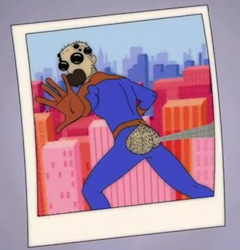Spider-Man’s Penis and Science Communication

Last year I wrote a post about Spider-man, and how his anatomy may not be…err, as PG as one might wish. In less than 500 words, I tried to write an entertaining post about how actual spider anatomy is not analogous to Spider-Man the superhero’s anatomy.
I did not expect to enrage Fanboys all over the internet quite as much as I did, but over all counted it as a science communication win. (I will confess to occasionally forgetting-on-purpose to hyphenate SpiderMan in this post because it makes Fanbois even madder, though. I am a bad person.)
And THEN: Scientifically Accurate Spiderman: The Video. Possibly NSFW.
This video is marked as ADULT, so you might have to go to YouTube and sign in to view it. The video takes a few elements of what I wrote and puts it in a blender to make a cartoon that is… interesting?
I transcribed some of the more puzzling lyrics of the song here:
Vaguely Scientifically Accurate:
- “His web erupts from out his ass”: Closer to the truth than actual Spider-Man, although technically webbing would erupt from spinnerets located near his taint. Technically. In an imaginary universe where Spider-human hybrids don’t immediately DIE.
- “Four pairs of eyes”: While this isn’t true of all spiders, it is correct for most.
- “His dick falls off”: How they got from “spiders don’t have a penis like a human” to “his dick falls off multiple times, and usually ends up in someone’s food item,” I’m really not clear. As a side note, I’m impressed that the penis in the video apparently has its own, separate Spider-man costume. I always just assumed Spidey tucked left in the leotard.
Not Even Close to Scientifically Accurate:
- “It’s a science fact spiders are gay” WHUT?
- “There are 250 spiders on your skin” WHUT WHUT?
- “Spiders produce milk.” This could the most hilarious misunderstanding of transgenic goats that produce spider proteins ever. Alternately, they might be thinking of milking spiders for their venom. Which…still makes no sense, because why does ‘Scientifically Accurate Spider-Man’ have nipples?
This is a video made for humor and shock value. I see nothing wrong in this. But where did the strange “facts” in this video come from?
It turns out there’s a lot of extremely bogus spider facts online. The top result for “Fun Facts About Spiders” is this list. Two examples from that site–and note these are NOT TRUE:
“A single strand of spider web has more potential energy than the bomb dropped on Nagasaki… Because spiders do not naturally exist in areas of high fusion, there is little danger to the average person.”
“The average human autopsy procedure in Chicago, IL will reveal roughly 250 small spiders living at points throughout the endocrine and circulatory systems. In New York, NY the average is upwards of 800.”
Those are pretty hilarious. Except.
When I posted a couple of these (Not True!) excerpts on Twitter (because, again, hilarious!), lots of people did not know they were false. They saw someone that looked vaguely authoritative tweet:
“Did you know that spiders with hair on them are mammals, and thus produce delicious (and unusually cold) milk?”
And they went along with it. They have all been taught that mammals have fur and produce milk, so…“Hey! Spiders are furry, aren’t they? Who knew they also had milk? Damn, I learn so much from Bug Girl! Spiders are involved in the dairy industry!”
Those of us with expertise in an area tend to forget that not everyone has the same background base of knowledge we do. FAIL on my part for not making it clear enough that those were bogus factoids, and assuming that everyone else would get the joke.
The “facts” in this video turn out to have a similar explanation. When you look at the “references” listed on the video, the list contains info from the Annual Review of Entomology, Biology Letters,….and the video creators included several of these “Fun Facts About Spiders”.
Oh dear.
Critical Evaluation of Online Information Fail.
But this whole series of miscommunications brings up a lot of really interesting questions about the internet and science communication.
Look, no human-spider hybrid will ever really be viable. If Spidey develops book lungs, for example, he’s going to collapse and die from lack of oxygen. Spiders don’t have capillaries, veins, and arteries like we do, and a large animal–with or without red spandex compression tights–just doesn’t work very well without a circulatory system.
Who cares? It’s science fiction.
I love science fiction! I’m all about willing suspension of disbelief–IF the magic hand-wavey timey-wimey bits are clearly not real. I don’t really care that Spider-Man is not anatomically correct. I tried to connect spider anatomy with pop culture in order to get readers. I focused on the web spinning and penile aspects of Spider-Man to get readers. Sadly, very few people are going to post a technical story about spider spinnerets on Facebook. “OMG check out the cribellum on this Araneomorph spider!! Wicked Cool!”
The problem for those of us trying to communicate science online is that we forget not everyone is in on the joke. The Onion is a well known news parody site–to nerds like me on the internet. But The Onion doesn’t make it obvious to people seeing it for the first time that it’s a parody. It’s not real. But people mistake it for real news on a fairly regular basis. How do we make sure that everyone knows a joke is a joke? Without completely killing said joke because we explained it?
 Part of the challenge I give myself with this blog is to try to make insects and their spineless relatives fun and interesting, and not be dry, technical and pedantic. That also means I cut some corners.
Part of the challenge I give myself with this blog is to try to make insects and their spineless relatives fun and interesting, and not be dry, technical and pedantic. That also means I cut some corners.
At the same time I was trying to be relevant and bring in new readers, I also was getting pushback from spider experts for oversimplifying spider pedipalps. Male spider pedipalps really are amazing sexual organs–and they really do break off during sex. Is a copulatory palp the same as a penis? Depends on who you ask.
Male spider pedipalps are modified, paired mouthparts involved in reproduction. Frankly, I’m rather sad that I didn’t think to suggest that Spider-Man’s penis would migrate up his abdomen to his neck and duplicate itself.
I don’t know how to walk that line between fun and technical accuracy perfectly–this whole blog is a performance piece. Done on the internet, with everyone watching and commenting. No pressure!
I think that the overall goal of getting more people to know something about spiders–even if it’s freaky genital factoids–balances out some of my not 100% accuracy in terms of specialized terminology.
And here is where I ask you to write the rest of the post.
How best should we deal with misinformation on the internet like fake spider “facts”?
Is not being detailed about technical science items the same/different than the fake factoids? Does it matter?
DISCUSS.
Additional Resources:
- Common Myths about Spiders
- No Follow: how to keep bogus sites from getting Google juice when you link to them
- Possibly the best evolution video ever. With not quite science facts
- Details of spider copulatory organs with no snark and just science
Some tips from a publication about trying to correct misconceptions:
- Provide an explicit warning before mentioning a myth, to ensure people are cognitively on guard and less likely to be influenced by the misinformation.
- Consider what gaps are created by your debunking and fill them with an alternative explanation.
- There is a risk of a backfire effect when original misinformation is repeated and thereby rendered more familiar.
- To avoid making people more familiar with misinformation (thus risking a familiarity backfire effect), emphasize the facts you wish to communicate rather than the myth.





It’s a scientific fact that bug girl posts rock :)
I think I came across a link to Wikipedia’s Common Misconceptions page on Skepchick:
http://en.wikipedia.org/wiki/List_of_common_misconceptions
I think it’s a great way to try to counteract fake facts. You could make a “Common Bug Misconceptions” page. I’d read it.
“Common Myths about Spiders” in the Additional Resources section is absolutely worth a read. I’m never going to put a spider outside again!
I’m pretty sure I *have* eaten a spider that crawled inside my mouth while I was asleep.
About 10 years ago (i.e. I was an adult), I was very sick for about a week. One day I woke up and my mouth felt awful, like it was full of lint and very dried out. I used a Kleenex clean all the gunk out, mostly between my gums and lips, took a large drink of water, and went back to sleep. A few days later, when I felt enough better to get up and about, I was cleaning up my bedroom and found the used tissue on my nightstand. It had a dead spider (or at least the exoskeleton of one) plastered to the dried mucus. So it either crawled into my mouth and died or molted ( Do spiders molt?), and dissolved in my saliva. Yuck! Then I heard about the “you eat 20 spiders and hundreds of insects in your sleep over your lifetime” legend and stopped worrying about it. But now I find out that’s not true! So is the real number much smaller, or zero for most people? Could eating the spider have actually caused or worsened my illness?
P.S. On the other hand, my niece once kissed a spider, or so her big sister reported. I asked her about it, expecting to get a denial, but all she said was “But it was sooooo cute!”
At autopsy, “small spiders living at points throughout the endocrine and circulatory systems.” I wonder if that is referring to spider nevi found in advanced liver disease? The clue is that these are thought to be caused by increased levels of estrogen, hence “endocrine system”. Misunderstanding not helped by sloppy terminology abbreviating the lesions to “spiders” as here
http://www.ijdvl.com/article.asp?issn=0378-6323;year=2008;volume=74;issue=4;spage=397;epage=398;aulast=Vedamurthy
Oh, that is really fascinating! Thanks for finding that!!
No worries! Glad to return the favour – I learn so much here each day.
Still giggling over that Sasquatch video – furry con indeed!
You have a great grin – I could see the evil thought form!
Along similar lines is the classic essay “Man of Steel, Woman of Kleenex” speculating on Superman’s sex life.
http://www.pwhitrow.com/blog/entries/2009/07/07/man-of-steel-woman-of-kleenex/
http://tvtropes.org/pmwiki/pmwiki.php/Main/ManOfSteelWomanOfKleenex
I was wondering if the spiders on your skin thing came from Demodex, they are of the class arachnida after all so close enough for online bullshit :-)
http://www.psmicrographs.co.uk/follicle-mite-nymph–demodex-folliculorum-/science-image/80016311
I would have thought there are a lot more than 250 on your skin though given they live in hair follicle depressions even on your face. Research shows these little fellas could be a cause/contributory factor to rosacea (Adult acne) given they eat and eat but have no bum holes so presumably at some point explode mite poo all over your face and release spot creating bacteria. Quite cool to think they are crawling around on you right now….
MMM, I can’t wait for the next tasty explosion!